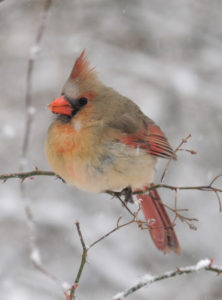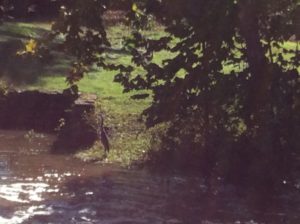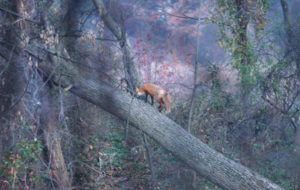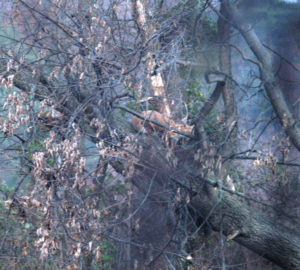by Heather Fenyk, LRWP President
As we move toward the shortest and darkest day of the year, and as the winter constellations take their places in our night sky, my family seeks out landscapes freed from the trespass of streetlights to check in with Orion, Taurus, Auriga, Perseus, Cassiopeia, Gemini, and Canis Major. These forays are times to marvel at the grandness of the universe, and give us pause to reflect on our place in it.
Winter Constellations of the Northern Hemisphere
Image credit: Carolyn Collins Petersen
However, just like our terrestrial landscapes, even our views of the night sky need protecting. Did you know that fully 80% of the American population lives where they cannot see the Milky Way with the naked eye? Light pollution not only compromises our views of darkness and the heavens, it has implications for functioning of life on earth by changing bat and moth behavior, threatening rainforest regrowth, and contributing to the decline of firefly populations across the globe. Many towns around the world are adopting “Dark Sky Initiatives” to remind us that our lands and skies are interconnected, and that like our waterways and our forests, our dark skies need protecting.
It is the season of lights. Our houses and streets are glowing with color. We string the Christmas trees with miniature glowing orbs, set out the diya, and light the candle in the Menorah. The visual display is joyous, festive, welcoming and wonderful. But consider adding a new tradition to your holiday calendar: turn off your lights and go out to gaze at the brilliance of the winter sky.
My family will do just that during our annual visit to Rutgers’ Serin Observatory during “Public Open Nights.” There we observe the night sky through the 20-inch optical telescope. Barring inclement weather, on December 13, 20 and 27 the (unheated) observatory will be open for two hours starting at 8:30 p.m. We are hoping for clear views of M31, Almach, NGC 457, h & χ Persei, η Persei, M45, M42, Betelgeuse, Sirius, Neptune-Mars appulse, Uranus, and the Moon.
As we scan the skies and take in the vastness of things, remember to take stock of your power to affect positive change in the here and now. Even in urban light polluted areas like the Lower Raritan Watershed there are things we can do to save the stars:
- Light only what you need
- Use energy efficient bulbs and only as bright as you need
- Shield lights and direct them down
- Only use light when you need it
- Choose warm white light bulbs.
Happy Holidays!
Article and photos by Joe Mish

A female cardinal fluffs up her feathers to ward off the cold, as winter wind sweeps the snow covered landscape.
The first breath of winter is felt in the last days of December’s autumn. The frigid wind, intent on erasing the last vestige of fall color, convinces reluctant rusted oak leaves to cleave from their lofty anchorage and sail free. The dry, stiff leaves rattle their objection before finally letting go to add depth to the leafy woodland carpet laid in October’s grand leaf fall.
The branches swept clean of obstruction; darkness deepens as theatre lights fade to heighten the drama of winter’s opening curtain featuring the winter solstice and the birth of light.
The winter solstice describes the time of the year at which the tilt of the earth is such that the sun appears at the lowest point above the horizon. ‘Solstice’, directly translates to, ‘sun stands still’. An impression one gets when the earth’s tilt changes to make the sun appear to halt an instant before it changes direction and ‘rises higher’ on the sky on the first day of winter.
Early observers reasoned the earth was a stable platform and the sun moved from one horizon to the other, above the earth. During the course of the year, the height of the sun was noted each day, measured in some primitive way. Stonehenge comes to mind as one version of tracking periodic celestial events, which led to the concept of time. Days and months were easy events to track and filled in the gap to mark time and define seasons.
That predictability was noted and celebrated as a whisper from the gods, sharing the future forecast of animal migration, weather and plant succession with those who pleased them.
The shortest day of December, which translates to the darkest day of the year, occurs on the last day of autumn. At the instant of the deepest darkness, the wick of the winter candle is lit, glowing like a beacon, getting brighter each day as winter progresses.
Look at a sunrise/sunset chart, cross referencing minutes, hours and days against months, to provide a visual representation of day length over time. Though you may not have noticed the change over a few days, you are now conscious of the minutes of light gained each day. That tangible bit of information acts like bio feedback and goes a long way to physically quell the sadness that the dark winter will never end.
Even if you forgo charting daylight, your body has physiologically evolved to capture trending day length and alters your hormones and mood accordingly. The pineal gland at the base of the brain monitors the day length to mediate release of hormones, primarily melatonin, which affects sleep cycles and behavior.
An odd situation, when you consider that while being consciously unconcerned or oblivious to changes in day length, your pineal gland is hard at work, keeping track.
A candle, glowing in a distant window, giving off a flickering halo of warm amber light, is a perfect tribute to mark the early days of winter and celebrate the birth of light.
This year, winter arrives December 21, at 5.22 pm, so make a conscious effort to mark the time and celebrate the first flicker of light that grows longer each day to make the winter much brighter and improve your mood.
December owns first rights to freezing weather and whimsically decides just which week will host the initiation of winter. The calculated movement of the planets determine the exact moment of the winter solstice right down to the second. Practically, however, winter begins when December decides.
Author Joe Mish has been running wild in New Jersey since childhood when he found ways to escape his mother’s watchful eyes. He continues to trek the swamps, rivers and thickets seeking to share, with the residents and visitors, all of the state’s natural beauty hidden within full view. To read more of his writing and view more of his gorgeous photographs visit Winter Bear Rising, his wordpress blog. Joe’s series “Nature on the Raritan, Hidden in Plain View” runs monthly as part of the LRWP “Voices of the Watershed” series. Writing and photos used with permission from the author.
Article and Photos by Margo Persin, Rutgers Environmental Steward
Editor’s Note: In 2018 Margo Persin joined the Rutgers Environmental Steward program for training in the important environmental issues affecting New Jersey. Program participants are trained to tackle local environmental problems through a service project. As part of Margo’s service project she chose to conduct assessments of a local stream for a year, and to provide the data she gathered to the Lower Raritan Watershed Partnership (LRWP). Margo keeps a journal of her experiences, excerpts of which are included in the LRWP’s “Voices of the Watershed” column.
This visit to the Ambrose Brook in Middlesex, NJ took place on a sunny, blustery fully autumn day. I didn’t know what to expect in regard to this visit, given that Hurricane Michael had blown through NJ the previous day. What was most impressive about the site was that it was imbued with a sense of energy and even restlessness, perhaps a carryover from the weather event of the day before. As I wandered along the stream bank, my attention was caught by the wind, strong gusts that kicked up dust and a trail of early falling leaves that scattered along the footpaths, the banks of the moving brook, and settled momentarily on the water. There was plentiful sunshine, open blue sky, a few scattered clouds that gave scant shadow on the earth, but… fall is in the air. The surrounding trees have not yet lost all of their leaves, but it is evident that the summer heat and earth’s natural cycle are performing their annual duty: the tree color is washed out, leaves are drying out and there is more space between the upper branches, as evidence of the drying and falling leaves. The tall grasses at various points on the stream banks have taken on a brownish hue, in contrast with the deeper green of the earlier summer months. Is there a change in the sunlight’s power? I tend to think so. In resting for a few moments on the banks of the stream on a strategically placed bench, I noted that the angle of the sunlight was lower, so the sun’s rays and warmth were mitigated by the obvious change of season, the rotation and tilting of our green planet here in the northern latitude toward winter. Oh, don’t utter the word!

The restlessness that I noted previously can be attributed to the energy that is expressed in the pulsing of the planet via various sources: the movement of the wind, as noted in the trees, grasses and leaves, the rustling and creaking of overhead branches, and the comings and goings of the Canadian geese. For this visit, various groups of geese appeared to be organized into elite squadrons, squawking their arrivals and departures on clearly defined areas of the brook, which took on the function of an aquatic airport, an avian Newark Liberty, as it were. None were to be found on the grass or footpaths. In contrast with earlier visits during spring and summer; for this visit, the geese were supremely active, aggressive even, as if protecting given areas on the water’s surface for their landings and take-offs. I wonder if their ancient memory of paths of fall migration was contributing to their agitation. Their honking and hissing carried from all along the footpath. Other birds that were noted were hearty and intrepid blue jays, who with their size and weight, seemed to be able to tolerate the wind’s gusts and buffeting, as well as a privacy seeking blue heron. The latter was tucked into a quiet shallow at the base and to the side of the waterfall, likely an attempt to avoid and ignore the noisy Canadian geese. (This last comment is a glaring example of anthropomorphism, I know, but those geese really are quite vocal, pushy and …mildly annoying.) Ground squirrels, who appear to be in fine flesh, have begun to heed autumn’s warning, several were observed collecting and munching on the first fall of acorns from the surrounding oaks.

Ambrose Brook was swollen and fast moving, manifesting a steady and plentiful flow, with even some white water at the base of the waterfall. Although I had not brought any measuring equipment for this visit, my ‘guess-timate’ based on visual measurement alone as to water depth was approximately 8-10 inches closer to the bank and 12-15 inches toward the center of the stream and past the small waterfall, surely because of the rainfall from Hurricane Michael. The stream had lots of surface ripples, which acted as prisms for the sunlight, and thus produced a dancing refraction of water, waves, and light. Lovely.
So, this cycle of observation and assessment of mine will soon be drawing to a close. My commitment was for a year’s worth of visits and measurements. Given that I began in December of 2017, only a few more visits remain. Now that autumn is upon us, I am struck by the wholesomeness of this process and how the observation of nature’s constant change ironically demonstrates its sureness and constancy. The beauty of each season does not depend on human intervention – nature and the environment are enough, in and of themselves.
Article and photos by Joe Mish


Expect the unexpected when you look up into the leaf bare November woods. Here a red fox walks up a leaning tree to rest 30 feet high in the crotch of an adjoining tree. Red fox are not known to climb trees as are gray fox., but this fox channeled his inner gray fox to climb to dizzying heights.
November is the far side of autumn, a time when the colorful drapery of October is taken down to reveal the bare structure, upon which fluorescent orange leaves once hung.
The change in scenery is quite dramatic, as we pass through the colorful curtain that decorated the first full month of fall. I imagine standing behind a waterfall where colorful autumn leaves flow like cascading water to create a transparent wall of scarlet, orange and yellow. As I reach out to part the flowing colors, I step forward into November.
Linear brush strokes of gray and brown now dominate. Light and rain play with intensity of tone as the bare trees alternate between tans and gray to darker shades of brown and black. Rain saturates the branches to shift subtle earth tones to the bold end of their color spectrum.
The fading light of dusk and early light of dawn erase all color to turn trees into black silhouettes. The interlaced network of branches and solitary trees become one dimensional, as any perception of depth is lost against the stark contrast enhanced by the loss of daylight.
A dynamic lightshow in the sky then commences with a pale yellow glow as the sun departs over the horizon to melt into a pool of fiery orange. When the unmoving silhouetted trees are viewed against the ever changing celestial color spectrum, the still scene becomes a cinematic event.
Stars begin to appear well before the sun’s aura fades. Their sparkling silver brilliance is held against an even colored, dark blue night sky, making the perception of depth impossible to detect. Here, the background is static and the stars sparkle with energy. Just the opposite occurs where trees appear one dimensional and static, while the sky is alive with changing color.
All these theatric opposites combine in a single scene to create an inspiring, though brief preface, to the end of a November day.
A walk through the November woods cannot be more dramatically different than experienced a month before.
Strolling within the woods, beneath the canopy of trees, now without their leafy crowns, the lattice work of a branched arbor is apparent. Since late spring, a cloud of leaves dominated the view, banning shadows and sunlight.
A day time stroll on a sunny day or moonlit night, allows light to play with trunk and limb. Gnarled branches, which fought for their place in the sun, form grotesque figures that groan in the wind. The source of the sounds impossible to locate, lend a ghostly atmosphere even in the light of day. Shadows that begin to arise from a subterranean prison at the base of large trees, appear as immovable as the tree from which it escaped.
Turn away and back to find the shadow has imperceptibly moved, as it circles the tree to close the distance between you.
Walk along silently on the rain and color soaked carpet of October and let your imagination run wild. Animals and portions of human like figures, frozen in the transition of creation, hang like spare parts growing from trees.
While November is no one’s idea of autumn, given the cold, frost, barren landscape and introductory snowfalls, the month ends 21 days short of winter.
Author Joe Mish has been running wild in New Jersey since childhood when he found ways to escape his mother’s watchful eyes. He continues to trek the swamps, rivers and thickets seeking to share, with the residents and visitors, all of the state’s natural beauty hidden within full view. To read more of his writing and view more of his gorgeous photographs visit Winter Bear Rising, his wordpress blog. Joe’s series “Nature on the Raritan, Hidden in Plain View” runs monthly as part of the LRWP “Voices of the Watershed” series. Writing and photos used with permission from the author.






